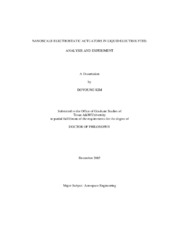| dc.description.abstract | The objective of this dissertation is to analytically model a parallel plate
electrostatic actuator operating in a liquid electrolyte and experimentally verify the
analysis.
The model assumes the system remains in thermodynamic equilibrium during
actuation, which enables the ion mass balance equations and GuassÂ’ Law to be combined
into the Poisson-Boltzmann equation. The governing equations also include the linear
momentum equation including the following forces: the electric force, the osmotic force,
the spring force, the viscous damping force, and the van der Waals force. Equations are
also derived for the energy stored in the actuator. The analytical results emphasize the
stored energy at mechanical equilibrium and the voltage versus electrode separation
behavior including the instability. The analytical results predict that the system may not
be a good actuator because the displacement has a very limited stable range, although the
actuator would be suitable for bistable applications.
The experiment consisted of a fixed flat gold electrode and a movable gold
electrode consisting of a gold sphere several micrometers in diameter mounted on the end of an Atomic Force Microscope (AFM) cantilever, which serves as the spring. The
electrodes were separated by approximately 100nm of 1mM NaCl aqueous solution.
The analytical results were not verified by the experiment. Relative to the analysis,
the experiments did not show distinct critical points, and the experiments showed less
electrode separation for a given applied electric potential. The experiments did show
points at which the electrode separation versus electric potential rapidly changed slope,
which may be instability points.
It is suggested that this phenomenon may be due to coalesced gas bubbles on
hydrophobic regions of the electrode surfaces, which are not included in the model.
Although clean gold surfaces are hydrophilic, gold surfaces may become hydrophobic
due to impurities. | en |


